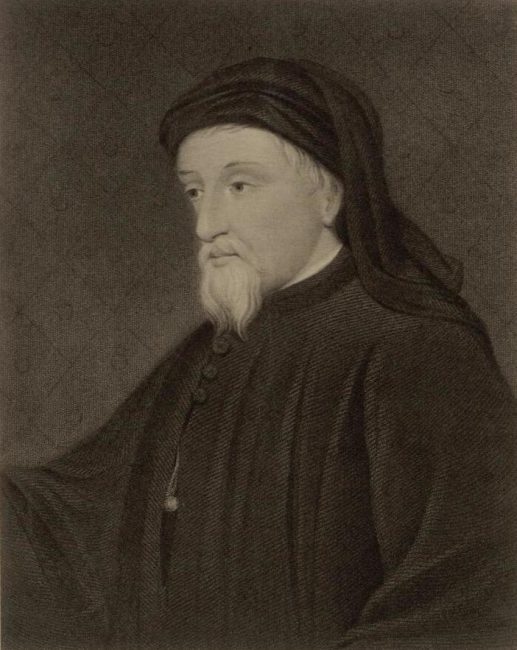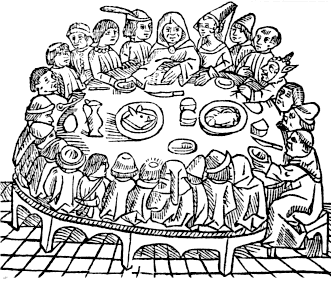
Geoffrey Chaucer (1342/43 – 1400)
On October 25, 1400, English poet Geoffrey Chaucer passed away. Known as the Father of English literature, Chaucer is widely considered the greatest English poet of the Middle Ages. He is best known today for The Canterbury Tales and was the first poet to be buried in Poets’ Corner of Westminster Abbey.
Whan that Aprill with his shoures soote
The droghte of March hath perced to the roote,
And bathed every veyne in swych licour
Of which vertu engendred is the flour;
Whan Zephirus eek with his sweete breeth
Inspired hath in every holt and heeth
The tendre croppes, and the yonge sonne
Hath in the Ram his halve cours yronne,
And smale foweles maken melodye,
That slepen al the nyght with open ye
(So priketh hem nature in hir corages);
Thanne longen folk to goon on pilgrimages.
— Geoffrey Chaucer, The Canterbury Tales, General Prologue, l. 1-12
Early Life
Chaucer came from a wealthy London wine merchant family. The first written mention of his name can be found in 1357 in the household book of the Countess of Ulster, Elizabeth de Burgh, the wife of Prince Lionel of Antwerp. Lionel, a son of King Edward III, was one of the commanders of the French invasion in 1359. Chaucer also took part in it as a soldier and in 1360 was captured by the French at Reims for a short time, but bought back for £16. During the peace negotiations in Calais, which were initiated shortly afterwards, he was a courier in Lionel’s service.
After that no historical trace of him can be found until 1366. From this year a letter of protection of King Charles II of Navarre is handed down, who granted Chaucer and three companions free escort through his kingdom up to the Castilian border. In the following years Chaucer repeatedly carried out diplomatic missions on behalf of the English king.
Marriage and Travels
In 1366 he married Philippa Roet, a court lady of the king’s wife Philippa of Hainaut and daughter of Sir Gilles, called “Paon de Roet”, who had come to England in the wake of the king’s wife. From 1367 Geoffrey Chaucer was listed as a member of the royal household, sometimes as valettus (valet), sometimes as esquier (squire), at least as a member of a group of about 40 men, which was to be of general use at court. He probably also studied at the Inns of Court, the London School of Law. From 1366 to 1370 he was sent abroad four times by royal order and travelled France, Flanders and probably also Italy.
His first literary achievement is probably his translation of the French Novel de la rose into Middle English. His first own poem is considered to be the Duchess’s Book, an eulogy for Blanche of Lancaster, who died in 1368. 1372-73 he travelled Genoa and Florence on a royal commission. On this journey at the latest he learned Italian, and probably also came into contact with the poems of Boccaccio [1] and Dante [2] for the first time, after whose model he later wrote the Canterbury Tales.
Career and Downfall
In 1374 he was appointed customs inspector for the export of wool, fur and leather. At that time wool was England’s most important export article. From the year 1380 a court document is handed down, in which Chaucer is absolved of the reproach of having perpetrated raptus on a baker’s daughter. Researchers are still arguing about whether this crime can be translated as “rape” or “kidnapping”. After 1382 he increasingly delegated the work in the customs house to his deputies, and in 1385 he moved to Kent. Already one year later he represented this county in the House of Commons, the English House of Commons.
However, his close ties to the royal court became his downfall in 1386, when the parliamentary opposition prevailed against King Richard II and John of Gaunt; all his offices were revoked. In 1387 Chaucer’s wife died, and despite his previous commode income, he now accumulated debts. In 1390 Richard II appointed him clerk of the works, i.e. supervisor of the royal building projects. In this function he was robbed by brigands in September of the same year; some researchers suspect that Chaucer staged the robbery in order to settle his debts with the allegedly robbed money. After only one year, his office was revoked. Instead, he was appointed forest supervisor of the royal forests in North Petherton, Somerset County, and maintained contacts with the royal court in the following years. During this time, most of the Canterbury Tales also emerged.
Later Years and Death
When Henry IV, the son of Chaucer’s late patron John of Gaunt ascended the English throne in 1399, Chaucer’s annual salary was increased considerably; however, the poem The Complaint of Chaucer to his Purse attributed to Chaucer is interpreted as an indication that the money was not paid. He settled in London again, but died a year later, presumably on 25 October 1400 – at least this is the date that can be read on his tomb today; however, it was not erected until the 16th century.
The Father of English Literature
Geoffrey Chaucer is considered the founder of modern English literature. Although Old English had produced a rich literature in the early Middle Ages, this writing tradition ended abruptly after the Norman invasion of 1066. From then on, French or Anglo-Norman was the language of the upper and educated classes. It was not until the 14th century that English regained its prestige and Chaucer was one of the first to use it as a literary language and is therefore regarded as the “father of English literature“.
The Canterbury Tales

Canterbury Tales, Woodcut 1484
His work is strongly influenced by ancient, French and Italian models, but also contains metrical, stylistic and content-related innovations that founded the independence of early English literature. Most of the Canterbury stories were written after 1388, in Chaucer’s “English” phase. Nevertheless, his literary model is Boccaccio’s Decamerone (1353).[1] From this collection of 100 novellas, Chaucer adopted above all the organisational principle of the framework plot; the stories themselves are original Chaucer’s creation.
The famous prologue provides the setting for the event: the poet is on a pilgrimage to the tomb of Saint Thomas Becket in Canterbury.[3] In a tavern on the outskirts of London, he joins a group of 29 like-minded people and joins them. The innkeeper of the restaurant suggests that each of the pilgrims should tell two stories on the way there and back, also with the ulterior motive of keeping the guests in a drinking mood. In the prologue, Chaucer characterizes each pilgrim in short but very realistic portraits. The result is a reduced image of the English society of the time, because every stratum is represented, from the knight to the nun to the farmer. A pilgrimage was the only plausible occasion on which such a colourful society would actually have found each other, and so the plot framework proves to be an instrument of realistic representation.
Of the 120 stories originally planned, Chaucer completed only 22, and two others remain fragments. The diversity of the Canterbury Tales is what makes them so attractive. Chaucer gave each of his pilgrims a characteristic language and a suitable story, so that a multitude of different genres exist side by side, but nevertheless represent a unity through the framing plot. In this way Chaucer is able to combine pious legends of saints, courtly poetry and coarse swings elegantly and without contradiction. In recent times, interpretations that interpret the Canterbury Tales as satire of the estates have proved particularly fruitful.
David E. Thornton. Bilkent HIST417 20111223 LECTURE21 Medieval Society & Chaucer’s Canterbury Tales, [8]
References and Further Reading:
- [1] Boccaccio and his Decameron, SciHi Blog
- [2] Dante Alighieri and the Divine Comedy, SciHi Blog
- [3] The Assassination of Thomas Becket, SciHi Blog
- [4] Geoffrey Chaucer at Encyclopædia Britannica
- [5] Works by or about Geoffrey Chaucer at Wikisource
- [6] Digitised version of Caxton’s edition of Geoffrey Chaucer’s Canterbury Tales (1476-83), at the British Library
- [7] Geoffrey Chaucer at Wikidata
- [8] David E. Thornton. Bilkent HIST417 20111223 LECTURE21 Medieval Society & Chaucer’s Canterbury Tales, CosmoLearning @ youtube
- [9] Butterfield, Ardis. “Chaucer and the idea of Englishness”. History Extra
- [10] Hopper, Vincent Foster (1970). Chaucer’s Canterbury Tales (Selected): An Interlinear Translation. Barron’s Educational Series.
- [11] Fruoco, Jonathan (2020). Chaucer’s Polyphony. The Modern in Medieval Poetry. Berlin-Kalamazoo: Medieval Institute Publications, De Gruyter.
- [12] Bisson, Lillian M. (1998). Chaucer and the late medieval world. New York: St. Martin’s Press.
- [13] Timeline for Geoffrey Chaucer, via Wikidata





